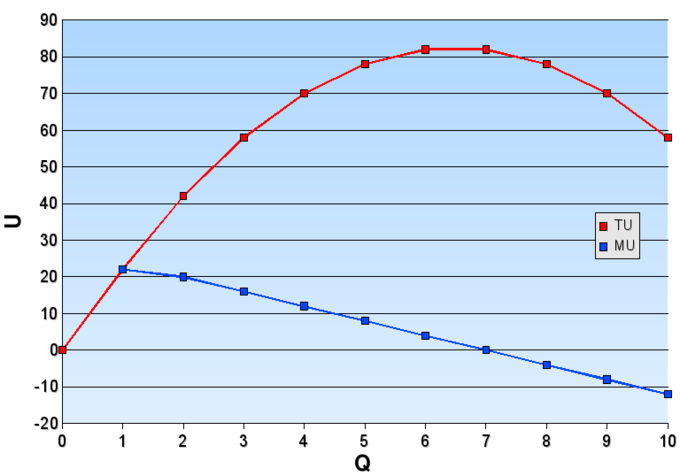5.1: The Demand Curve and Utility
- Last updated
- Save as PDF
- Page ID
- 3456

- Boundless
- Boundless
Defining Utility
Utility is an economic measure of how valuable, or useful, a good or service is to a consumer.
Learning objectives
Define Utility
Utility is a term used by economists to describe the measurement of “useful-ness” that a consumer obtains from any good or service. Utility may measure how much one enjoys a movie or the sense of security one gets from buying a deadbolt. The utility of any object or circumstance can be considered. Some examples include the utility from eating an apple, from living in a certain house, from voting for a specific candidate, or from having a given wireless phone plan. In fact, every decision that an individual makes in their daily life can be viewed as a comparison between the utility gained from pursuing one option or another.

Apples and Oranges: Utility allows you to compare apples and oranges based on which you prefer.
Utility may be positive or negative with no effect on its interpretation. If one option gives −15−15utility and another gives −12−12, selecting the second is not, as it might seem, the “lesser of two evils,” but can only be interpreted as the better option.
Utility can be measured in one of two ways:
- Ordinal utility ranks a series of options in order of preference. This ranking does not show how much more valuable one option is than another, only that one option is preferable over another. An example of a statement reflecting ordinal utility is that “I would rather read than watch television.” Generally, ordinal utility is the preferred method for gauging utility.
- Cardinal utility also ranks a series of options in order of preference, but it also measures the magnitude of the utility differences. An example of a statement reflecting cardinal utility is “I would enjoy reading three times more than watching television.” Given how difficult it is to precisely measure preference, cardinal utility is rarely used.
Theory of Utility
The theory of utility states that, all else equal, a rational person will always choose the option that has the highest utility.
Learning objectives
Explain the Theory of Utility
The theory of utility is based on the assumption of that individuals are rational. Rationality has a different meaning in economics than it does in common parlance. In economics, an individual is “rational” if that individual maximizes utility in their decisions. Whenever an individual is to choose between a group of options, they are rational if they choose the option that, all else equal, gives the greatest utility. Recalling that utility includes every element of a decision, this assumption is not particularly difficult to accept. If, when everything is taken into account, one decision provides the greatest utility, which is equivalent to meaning that it is the most preferred, then we would expect the individual to take that most preferred option. This should not necessarily be taken to mean that individuals who fail to quantify and measure every decision they make are behaving irrationally. Rather, this means that a rational individual is one who always selects that option that they prefer the most.

Consumer making a decision: When making an economically rational purchasing decision, a consumer must consider all of their personal preferences.
It is important to emphasize how rationality relates to a person’s individual preferences. People prioritize different things. For example one person may prioritize flavor while another person may value making healthy choices more. As a result the first person may choose a sugary cereal while the second may choose granola. Based on their preferences, both made the economically rational choice.
The rationality assumption gives a basis for modeling human behavior and decision making. If we could not assume rationality, it would be impossible to say what, when presented with a set of choices, an individual would select. The notion of rationality is therefore central to any understanding of microeconomics.
Marginal Utility
Marginal utility of a good or service is the gain from an increase or loss from a decrease in the consumption of that good or service.
Learning objectives
Define Marginal Utility
In economic terms, marginal utility of a good or service is the gain from an increase or loss from a decrease in the consumption of that good or service. The idea of marginal value is an important consideration when making production or purchasing decisions. A person should produce or purchase an additional item when the marginal utility exceeds the marginal cost.

Marginal Utility of Housing: The marginal utility of owning a second house is likely less than the marginal utility of owning the first house.
Marginal utility is measured on a per unit basis. When evaluating the marginal utility of any item, it is important to know in what unit utility is measured. The unit is based on the type of activity that you are trying to measure. If you are a consumer of potato chips, you might measure utility based on whether to buy another bag or have another hand full with your lunch. If you are a producer of potato chips, your marginal value might be defined by a pallet of potato chips. In general, marginal value should be measured based on the smallest unit of consumption or production related to the product in question.
It is also important to remember that utility is difficult to quantify since preferences vary based on the individual. Utility is rarely measured in terms of magnitude; utility is normally just about determining which option is the best choice. Since utility is rarely measured using cardinal means, it may seem difficult to determine a product’s marginal value. Economists get around this by substituting dollar values. While this may fail to capture a specific individual’s preferences and utility, it offers a good approximation based on everyone’s collective preferences as defined by the market.
Principle of Diminishing Marginal Utility
The principle of diminishing marginal utility states that as more of a good or service is consumed, the marginal benefit of the next unit decreases.
Learning objectives
Explain diminishing marginal utility
The principle of diminishing marginal utility states that as an individual consumes more of a good, the marginal benefit of each additional unit of that good decreases.
The concept of diminishing marginal utility is easy to understand since there are numerous examples of it in everyday life. Imagine it is a hot summer day and you are hungry, so you get some ice cream. The first bite is great and so is the second. But with each spoonful, your hunger decreases and you become cooler. So while the last bite might still be good, it is probably not as satisfying as the first. This is a simple illustration of diminishing marginal utility.

Total and marginal utility: As you can see in the chart, the more of a good you consume, the further its marginal utility decreases.
Negative Marginal Utility
While there are some circumstances where there will always be some marginal utility to producing or consuming more of a good, there are also circumstances where marginal utility can become negative. For example, while some antibiotics may be useful in curing diseases. However, if you take too much you can become sick or resistant to the drugs which could lead to future illnesses being incurable. So it is important to remember that “diminishing” does not necessarily mean to zero; you can have too much of a good thing.
Exceptions to the General Rule
This concept suggests a uniform steady decline of marginal utility, but that may not always be the case. There can be situations in which one might gain more utility from consuming a later unit of a good than from earlier consumption. If you are going on a date, for example, getting one ticket to a concert will have some utility but the second arguably has more because it enhances the value of the first.
Generally these exceptions occur when what is being consumed is a component of a larger whole. While utility may increase for a period, there is usually a “tipping point” where afterwards marginal utility decreases. Getting a third ticket for your date will have low marginal utility than the second.
Key Points
- Utility is measured by comparing multiple options.
- Utility can be positive and negative.
- Ordinal utility ranks a series of preferences without measuring how much more valuable one option is than another. Cardinal utility measures how much more preferable one option is in comparison to another.
- Ordinal utility is generally the preferred method of measuring utility.
- The rationality assumption gives a basis for modeling human behavior and decision making.
- Utility includes every element of a decision.
- Rationality is dependent on a person’s individual preferences. Therefore, what might be a rational decision for one person may not be a rational decision for another.
- Marginal utility is measured on a per unit basis.
- Since an individual’s utility is rarely measured using cardinal means, calculating a product’s marginal value for an individual may be difficult.
- Instead of trying to calculate a product’s marginal value for an individual, economists assign dollar values to products based on their market price. This allows economists to estimate a product’s marginal value based on all the consumer’s preferences.
- The idea of marginal value is an important consideration when making production or purchasing decisions. A person should produce or purchase an additional item when the marginal utility exceeds the marginal cost.
- If you consume too much, the marginal utility of a good or service can become negative.
- In some circumstances, the marginal utility of producing or consuming an additional unit will increase for a short period of time. Generally there will be a “tipping point” at which marginal utility will then decrease.
- Generally these exceptions occur when what is being consumed is a component of a larger whole.
Key Terms
- utility: The ability of a commodity to satisfy needs or wants; the satisfaction experienced by the consumer of that commodity.
- ordinal: Of a number, indicating position in a sequence.
- cardinal: Describing a “natural” number used to indicate quantity (e.g., one, two, three), as opposed to an ordinal number indicating relative position.
- Rational individual: A person who chooses the option that, all else equal, gives the greatest utility.
- marginal: Of, relating to, or located at or near a margin or edge; also figurative usages of location and margin (edge).
- cardinal: Describing a “natural” number used to indicate quantity (e.g., one, two, three), as opposed to an ordinal number indicating relative position.
- utility: The ability of a commodity to satisfy needs or wants; the satisfaction experienced by the consumer of that commodity.
- marginal benefit: The extra benefit received from a small increase in the consumption of a good or service. It is calculated as the increase in total benefit divided by the increase in consumption.
LICENSES AND ATTRIBUTIONS
CC LICENSED CONTENT, SPECIFIC ATTRIBUTION
- Principles of Economics/Utility. Provided by: Wikibooks. Located at: en.wikibooks.org/wiki/Principles_of_Economics/Utility. License: CC BY-SA: Attribution-ShareAlike
- Utility theory. Provided by: Wikipedia. Located at: en.Wikipedia.org/wiki/Utility...ifying_utility. License: CC BY-SA: Attribution-ShareAlike
- Cardinal utility. Provided by: Wikipedia. Located at: en.Wikipedia.org/wiki/Cardinal_utility. License: CC BY-SA: Attribution-ShareAlike
- Cardinal utility. Provided by: Wikipedia. Located at: en.Wikipedia.org/wiki/Cardina...tic_properties. License: CC BY-SA: Attribution-ShareAlike
- ordinal. Provided by: Wiktionary. Located at: en.wiktionary.org/wiki/ordinal. License: CC BY-SA: Attribution-ShareAlike
- cardinal. Provided by: Wiktionary. Located at: en.wiktionary.org/wiki/cardinal. License: CC BY-SA: Attribution-ShareAlike
- utility. Provided by: Wiktionary. Located at: en.wiktionary.org/wiki/utility. License: CC BY-SA: Attribution-ShareAlike
- Provided by: Wikimedia. Located at: upload.wikimedia.org/wikipedi...nd_Oranges.jpg. License: Public Domain: No Known Copyright
- Principles of Economics/Utility. Provided by: Wikibooks. Located at: en.wikibooks.org/wiki/Principles_of_Economics/Utility. License: CC BY-SA: Attribution-ShareAlike
- Principles of Economics/Utility. Provided by: Wikibooks. Located at: en.wikibooks.org/wiki/Principles_of_Economics/Utility. License: CC BY-SA: Attribution-ShareAlike
- Boundless. Provided by: Boundless Learning. Located at: www.boundless.com//economics/...nal-individual. License: CC BY-SA: Attribution-ShareAlike
- Provided by: Wikimedia. Located at: upload.wikimedia.org/wikipedi...nd_Oranges.jpg. License: Public Domain: No Known Copyright
- US Navy 060513-N-5174T-045 Lt.nTaylor Forester makes a few last minute decisions before purchasing a gold necklace from a Navy Exchange vendor aboard the Nimitz-class aircraft carrier USS Ronald Reagan (CVN 76). Provided by: Wikipedia. Located at: en.Wikipedia.org/wiki/File:US...n_(CVN_76).jpg. License: CC BY-SA: Attribution-ShareAlike
- Principles of Economics/Marginal Utility. Provided by: Wikibooks. Located at: en.wikibooks.org/wiki/Princip...rginal_Utility. License: CC BY-SA: Attribution-ShareAlike
- Marginal utility. Provided by: Wikipedia. Located at: en.Wikipedia.org/wiki/Marginal_utility. License: CC BY-SA: Attribution-ShareAlike
- Marginal utility. Provided by: Wikipedia. Located at: en.Wikipedia.org/wiki/Margina...rginal_utility. License: CC BY-SA: Attribution-ShareAlike
- marginal. Provided by: Wiktionary. Located at: en.wiktionary.org/wiki/marginal. License: CC BY-SA: Attribution-ShareAlike
- cardinal. Provided by: Wiktionary. Located at: en.wiktionary.org/wiki/cardinal. License: CC BY-SA: Attribution-ShareAlike
- Provided by: Wikimedia. Located at: upload.wikimedia.org/Wikipedia/commons/thumb/0/06/Paul_Cezanne_Apples_and_Oranges.jpg/304px-Paul_Cezanne_Apples_and_Oranges.jpg. License: Public Domain: No Known Copyright
- US Navy 060513-N-5174T-045 Lt.nTaylor Forester makes a few last minute decisions before purchasing a gold necklace from a Navy Exchange vendor aboard the Nimitz-class aircraft carrier USS Ronald Reagan (CVN 76). Provided by: Wikipedia. Located at: en.Wikipedia.org/wiki/File:US...n_(CVN_76).jpg. License: CC BY-SA: Attribution-ShareAlike
- All sizes | Housing | Flickr - Photo Sharing!. Provided by: Flickr. Located at: www.flickr.com/photos/jwthomp...c3bEud-9kL4yp/. License: CC BY: Attribution
- Principles of Economics/Marginal Utility. Provided by: Wikibooks. Located at: en.wikibooks.org/wiki/Principles_of_Economics/Marginal_Utility. License: CC BY-SA: Attribution-ShareAlike
- Marginal utility. Provided by: Wikipedia. Located at: en.Wikipedia.org/wiki/Margina...%23Marginality. License: CC BY-SA: Attribution-ShareAlike
- utility. Provided by: Wiktionary. Located at: en.wiktionary.org/wiki/utility. License: CC BY-SA: Attribution-ShareAlike
- marginal benefit. Provided by: Wiktionary. Located at: en.wiktionary.org/wiki/marginal_benefit. License: CC BY-SA: Attribution-ShareAlike
- Provided by: Wikimedia. Located at: upload.wikimedia.org/Wikipedia/commons/thumb/0/06/Paul_Cezanne_Apples_and_Oranges.jpg/304px-Paul_Cezanne_Apples_and_Oranges.jpg. License: Public Domain: No Known Copyright
- US Navy 060513-N-5174T-045 Lt.nTaylor Forester makes a few last minute decisions before purchasing a gold necklace from a Navy Exchange vendor aboard the Nimitz-class aircraft carrier USS Ronald Reagan (CVN 76). Provided by: Wikipedia. Located at: en.Wikipedia.org/wiki/File:US_Navy_060513-N-5174T-045_Lt._Taylor_Forester_makes_a_few_last_minute_decisions_before_purchasing_a_gold_necklace_from_a_Navy_Exchange_vendor_aboard_the_Nimitz-class_aircraft_carrier_USS_Ronald_Reagan_(CVN_76).jpg. License: CC BY-SA: Attribution-ShareAlike
- All sizes | Housing | Flickr - Photo Sharing!. Provided by: Flickr. Located at: www.flickr.com/photos/jwthomp...c3bEud-9kL4yp/. License: CC BY: Attribution
- Marginal-utility. Provided by: Wikimedia. Located at: commons.wikimedia.org/wiki/Fi...al-utility.png. License: CC BY-SA: Attribution-ShareAlike

